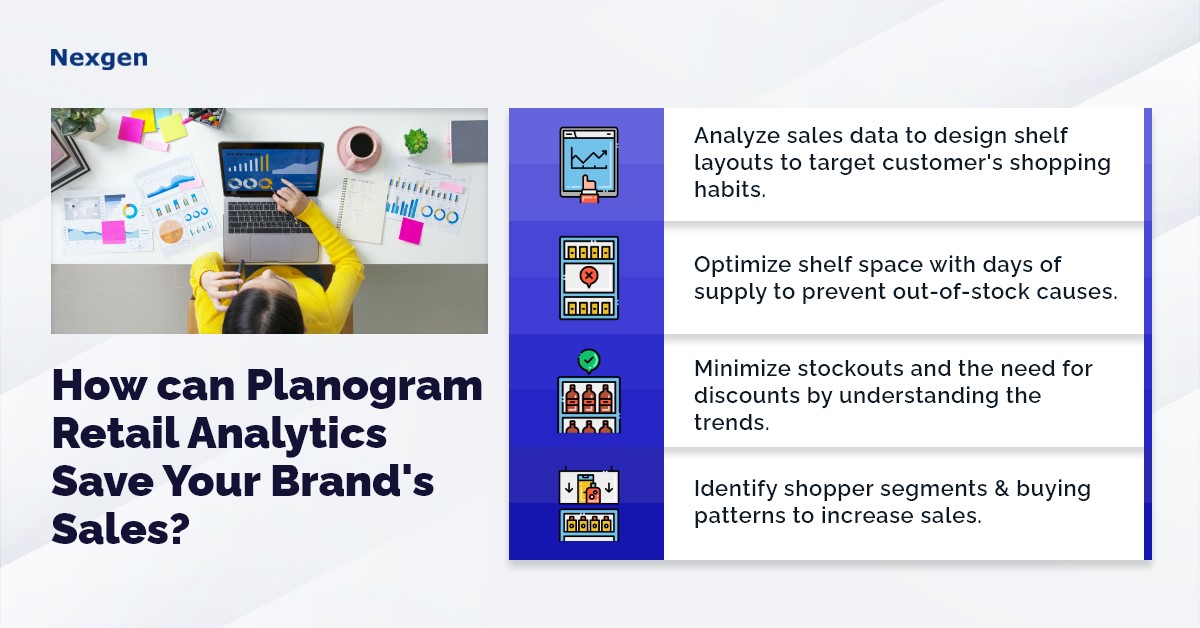Retailers used to rely mostly on their instincts to make decisions about shelf planning, inventory management, identifying which items would draw the attention of customers, and promotions. While retailers are often proud of their decisions based on instincts, it is not enough to boost profit margins. As consumer preferences and market conditions change, it will be difficult for retailers to accurately account for predicting the future. This is where planogram retail analytics steps in – a powerful tool that can revolutionize how retail brands manage their physical spaces and drive sales growth. Visual merchandising solutions such as planograms can help you obtain a detailed analysis of how shoppers pass through your shelves or what items do they prefer to purchase. This results in planning store shelves effectively and boosting sales.
How Does Planogram Retail Analytics Work?
Planogram retail analytics involves the strategic arrangement of products within a retail space to maximize sales and optimize the customer experience. This technique utilizes data-driven insights and advanced algorithms to design store layouts that resonate with customers and encourage desired buying behaviors. Here are some key reasons why retailers utilize retail analytics:

- Strategic product placement: Retailers can analyze past sales data and customer behavior to strategically position products within the store. By understanding customer preferences through planogram in retail analytics, retailers can design shelf layouts that cater to the target audience's shopping habits. This ensures high-demand and high-margin items are placed prominently, increasing their visibility and likelihood of purchase. This personalized approach enhances customer satisfaction, leading to higher conversion rates and repeat business.
- Ensure optimized shelf space: With the help of sales data, retailers can optimize shelf space by preventing overcrowding and ensuring efficient product organization. This creates a more pleasant shopping experience and encourages customers to browse, leading to increased sales. For example, apparel retailers can analyze sales data and fashion trends, to display items prominently by coordinating outfits or placing accessories on adjacent shelves to enhance customer engagement.
- Minimize stockouts and the need for discounts: Retailers can reduce the stockouts by understanding the trends with the help of sales data, so that they can have enough products on shelves. This results in the right amount of inventory on shelves, which reduces the chances of providing discounts to get rid of excess inventory. For example, planogram sales analysis reports can help you determine how quickly demand falls for apparel based on weather, consumer preferences, or market demand.
- Sales optimization: Planogram sales data can help retailers analyze sales patterns, trends, and customer behavior. This enables them to identify which products are performing well, which are slow moving, and why. For instance, retailers can track what items are out-of-stock, how appealing they are to customers, and how they influence buying decisions. Planograms can also help you identify shopper segments, preferences, buying patterns, and plan store shelves accordingly.
Overview of Nexgen POG
Nexgen POG is a robust and user-friendly cloud-based visual merchandising tool. It is designed for quick and efficient planogramming with minimal effort. Planogram in retail can be designed by easily dragging and dropping the products. The multi-device compatibility feature of POG allows you to obtain, share and edit planogram on any device, including your phone. It helps in designing store-specific planograms for increased product visibility and sales.
Get Your Free Trial Now!